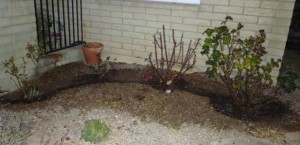After this morning’s inauspicious start, I ended the day feeling pretty good. Mighty good, as a matter of fact.
The roses have been looking peakèd, mostly because I’ve neglected them shamefully. They’ve hardly blossomed at all over the past couple of years. The ones in front are planted in rock-hard caliche, and even though they’re somewhat protected and have drip irrigators, they don’t get enough water. They suffered terribly through last summer’s endless spate of 118-degree days. The ones in back get either too little sun or too much sun, and they also haven’t been watered adequately.
The other day I happened to look over the vast collection of old pix in iPhoto, most of which feature the beautiful little flowers that have grown around my house in the past. Where have all the flowers gone? I wondered. Aside from a couple of cacti, no flowers have blossomed in the yard for a good year. On reflection, I realized I’ve been so depressed I haven’t felt like fooling with them. I pulled up the last of them when they ran out of juice, and that was that.
Also deceased: the vegetable garden, which was planted in large pots full of potting soil and compost.
It occurred to me that while I was pruning the roses, I could scrape back the gravel that sort of serves as mulch (and also covers the ground with stuff that doesn’t have to be watered), mix some fertilizer into all that dried-out potting soil/compost, and dig it in around each plant. This would serve to loosen up the hard soil at the same time as it would feed the roses.
This was quite the project: there are five rose plants in front, one of them with a cane as high as the eaves. Every summer a cactus wren builds a nest in this resurgent cane, and I so always feel bad about pruning it back. She doesn’t seem to mind, though: she just brings new twigs and weeds and rebuilds.
After I finished digging the fresh soil in around the four plants closest to the house, I realized that they reside along a slightly inclined plane…and that if I were to dig small trenches connecting their watering basins, I just might manage to water more than one of them with a single hose-drag. Maybe several of them. Hm…maybe even all four of them.
So, with great shoveling, dragging, and mounding of gravel, I finally got these little ditches built.

Because I got such a late start, it was about dusk by the time I reached this stage. That rose on the far right probably can stand some more pruning, but not today… When I put the hose on that plant and turned on the water, what should happen to my delight but within ten or twelve minutes, the water flooded all four rose basins!

What started out as an exercise in laziness—I didn’t want to have to move the hose four times to water the plants—turned into a nice little coup de frugalité. Not only does this require only one hose drag, it deep-waters all four plants in under fifteen minutes, with the spigot barely running. Ordinarily, to water these four plants, I have to move the hose to each basin and let it run about fifteen minutes per plant.
This will represent a significant saving, not only in hassle factor but more importantly in water! So, it was a nice discovery to stumble upon.
Yes, the roses do have drip irrigation, but for that system to work, you have to let it run six to eight hours a day, several times a week. Think of that! It’s like having four faucets leak, all day long, every two or three days. Experience shows that, ballyhooing be damned, drip irrigation saves nothing on the water bill and in fact often runs it up. It’s arguably more economical to take the hose out and water the plants by hand.
Now, it must be allowed that this arrangement leaves something to be desired in the aesthetics department. However, I have a plan.
First, move the hose pot that’s outside the courtyard wall out of sight, to the other side of the wall’s wrought-iron “window.” Then shovel out the gravel behind the plants, between the rose basins and the wall. Use that to fill areas where the gravel is thin, in other parts of the yard. Dig up the hard-pack soil, turning some more compost into it.
Then line the curvilinear border along the front edge with river rocks, easily obtained by walking up and down the neighborhood alleys. This will help to keep the gravel from working its way back into the planting bed. Possibly mulch with forest bark, creating a delineated planting bed that looks like I actually intended it to be there.
A friend gave me some seeds from her hollyhocks for Christmas. I’m thinking it would be neat to sow those in behind the roses, something that will be made possible by shoveling out the gravel. Hollyhocks don’t last long in the low desert, but they will grow here and blossom in the spring. Some bulbs would be nice there, too. Anemones, lots of anemones…
The sum total of the rose crop this fall filled three old bottles pressed into service as bud vases, shown here with Rosie the Dancing Rat, who resides on the dining-room table…

and one impromptu bud vase in the bathroom…

I hope there’ll be lots more in the spring.









